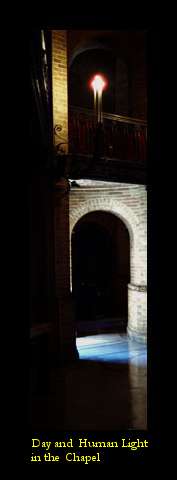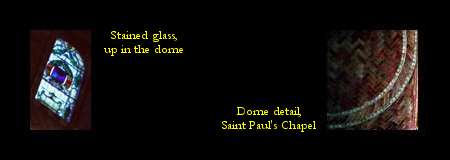|
THE SOUND OF SPACES

An investigation by composer and installation artist
JEFF TALMAN
<< Continued from yesterday
 In 1996 I moved to Prague and while there toured a number
of European countries. Cathedrals, basilicas, museums, castles were obvious
tourist magnets. But I also looked to the smaller spaces, and I found myself
returning to many. Something drew me to the spaces beyond their visual splendor:
the Cathedral of St. Vitus in Prague, the Duomo in Florence, the Notre Dame
cathedrals in Paris and Chartres, Westminster Abbey in London, even the
tiny Basilica of Christ of the Caves in Athens. In 1996 I moved to Prague and while there toured a number
of European countries. Cathedrals, basilicas, museums, castles were obvious
tourist magnets. But I also looked to the smaller spaces, and I found myself
returning to many. Something drew me to the spaces beyond their visual splendor:
the Cathedral of St. Vitus in Prague, the Duomo in Florence, the Notre Dame
cathedrals in Paris and Chartres, Westminster Abbey in London, even the
tiny Basilica of Christ of the Caves in Athens.
At first my awareness was purely intuitive, of this I'm certain. But
as I went from place to place I became stunned to realize that the sounds
of each, their room tones, were all very different. As I noticed this I
began to consciously search the spaces for silence - for that which registered
their nearly imperceptible sonic differences. The silences were variant,
imposing and majestic in themselves, and obviously never separable from
the spaces.
On returning to the States it occurred to me that I knew of no-one doing
any musical work that actually involved bringing a space's intrinsic sound
to the forefront as the actual program material of composition. I searched
through my stack of DATs to find pure room tone, incidentally recorded during
the course of a concert in a suitable space. I came upon my two songs for
solo soprano, Dreamers, which were recorded in 1987 in St. Paul's
Chapel at Columbia University in New York City. In that recording I found
1.1 second of pure room tone that had no shuffling, coughing or other audience
or performer noises.
At first listen, amplified and through headphones, it sounded much like
what one would expect - a sort of white noise only with various frequency
weightings. But with this I finally realized what I was hearing in all of
those silences. Each of those magnificent buildings is 'tuned' to a harmonic
spectrum. This is a naturally occurring process. The size, shape and materials
of a particular space dictate which frequency bandwidths will best operate
in the space. Certain frequencies, the standing waves, will 'fit' a room
and be resonantly in tune with that space, while other frequencies which
do not 'fit' will be truncated and reduced significantly in volume.
I performed a spectral analysis of the room tone from St. Paul's Chapel
and discovered that the space resonates to a harmonic series based on a
fundamental tone of F at 87 cycles per second. The tunings are nothing like
our well-tempered, just, mean tone or other temperings. They are wilder,
less precise and in the case of St. Paul's Chapel containing a subsidiary
D-flat tuning that competed somewhat with the F tuning. Still, my initial
intuitive realizations were proven: I was hearing differently tuned, complex,
highly resonant chords built on the harmonic series in the sound of spaces.
(As an aside, an interesting project might be to try to correlate the tunings
of organs in European cathedrals and the music written specifically for
each space with the spectral tunings of the particular space. My hunch is
that past masters knew which keys resonated the best in their spaces and
they took advantage of it.)

Continue >>
Copyright © Jeff Talman, November
21st 1999
 << Music &
Vision homepage Peter Grimes in Budapest >>
<< Music &
Vision homepage Peter Grimes in Budapest >>
|